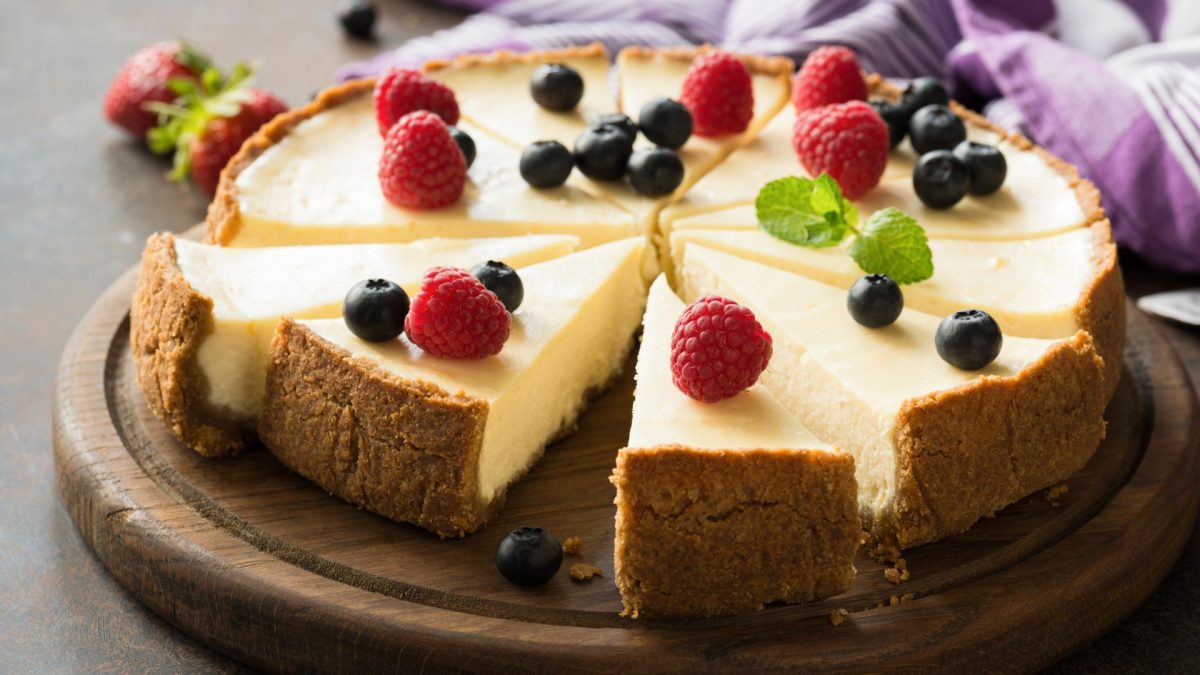(JNS) — Ready or not, Rosh Hashanah begins on the evening of Friday, Sept. 15, and lasts through sundown on Sunday, Sept. 17—the first two days of Tishrei in the Hebrew calendar. It coincides with Shabbat this year, so an especially grand festive meal is in order. But between now and Erev Rosh Hashanah, there’s still plenty of time to plan dishes and stock up on convenience items ahead of time. To make dishes sparkle, include some of the newer combination spices, like Moroccan spices or Seven Spice seasoning from Sadaf, which eliminates the need to have a variety of items on hand.
| RELATED: The Ultimate Rosh Hashanah Guide to family apple picking in St. Louis
Rosh Hashanah is one of my favorite holidays. Meals are steeped in tradition and symbolism. Childhood memories of sweet, finger-licking ingredients such as honey are used abundantly with the prayer that the coming year will be filled with sweetness. Sour or bitter foods are not served. For Ashkenazi Jews, the first items to be eaten are apple wedges in honey. Ripe, juicy pears are in season, so tuck in a few wedges of those as well or even firm plum slices as dipping tools. Sephardic Jews may start Rosh Hashanah with a seder. The origin of a Rosh Hashanah seder is said to have started more than 1,500 years ago, linked to a short passage in the Babylonian Talmud where foods such as squash, leeks and chard are mentioned. These vegetables grow quickly, relevant to growth in the New Year. A recipe for Braised Leeks is included below.
Everyone has a tried-and-true recipe for traditional dishes like brisket and kugels. But this year at Rosh Hashanah tables everywhere, there are sure to be those who are strictly vegetarian and even vegan, especially among the younger set. Some basic rules to follow: Those who follow a vegan diet abstain from the use of animal products (honey included). Their diet is based on fruit, vegetables, grains, nuts and food made from plants. Vegetarians typically omit meat, poultry and fish, though dairy and eggs are eaten. Some vegetarians do eat fish (pescatarians).
To meet the needs of varied guests, add something different to the menu this year. For vegans, serve dishes like the “Lentil” Liver with toasted pita bread and glasses of refreshing Pomegranate Gazpacho. An added bonus, these are best prepared one to two days ahead. Maple syrup may be used instead of honey. Finish off the meal with Halvah-Stuffed Dates. Sprinkle with chopped pistachios, make ahead and freeze, then remove to room temperature for two to four hours before serving. These may become a year-round favorite for cocktail hour.
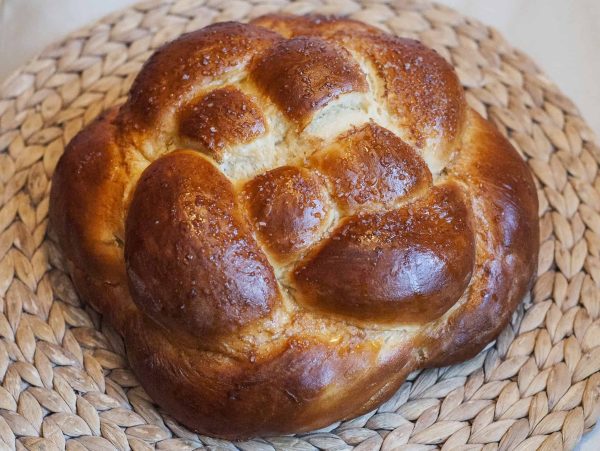
As for the glorious round challah—the symbol of eternal life—save time and buy loaves from a good kosher bakery or market. Brush with egg whites or olive oil, and sprinkle with a variety of seeds and dried herbs, symbolizing Israel’s Seven Species. Warm it in a preheated 350-degree oven for 10 to 15 minutes before serving. No one will ever know that it’s not home-baked.
Incorporate these items for Sukkot meals as well, which can be enjoyed heated or at room temperature outside in the sukkah, and also celebrate the bounty of the season. This year, the Jewish holiday of Sukkot also begins on Shabbat; it starts on the evening of Sept. 19 and lasts until sundown on Oct. 6.
L’Shanah Tovah—to a sweet, happy and healthy New Year!
HOLIDAY MENU
Pomegranate Gazpacho
Chopped “Lentil” Liver
Stuffed Salmon Fillets, Israeli-Style
Roasted Apples and Brussels Sprouts
Braised Leeks
Citrus Tabbouleh With Quinoa, Chickpeas and Peppers
Clove-Scented Pineapple
Halvah-Stuffed Dates
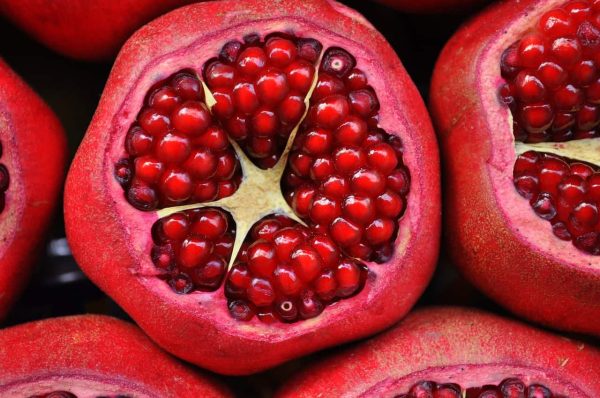
Pomegranate Gazpacho (Vegan, Pareve)
Serves 4
Cook’s Tips:
*Ingredients may be halved.
*Juice of two pomegranates equals half a cup.
*Serve in stemmed wine glasses.
Ingredients:
½ cup pomegranate juice (fresh-squeezed or bought)
1 rib of celery, cut into 1-inch pieces
1 cup watermelon chunks
1 cup pineapple chunks
¼ orange, seeded, unpeeled and cut into chunks
Directions:
Place all ingredients in a blender jar or food processor. Blend or process until smooth.
Serve chilled.
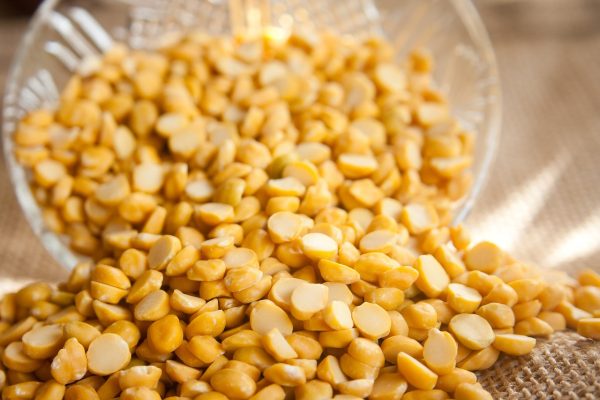
Chopped ‘Lentil’ Liver (Vegan, Pareve)
Makes 3 cups
Cook’s Tips:
*Substitute 3 cups of cooked, drained lentils for store-bought.
*Sumac has a tart flavor similar to lemon juice.
*Store-bought Moroccan spice is a blend of spices such as cinnamon, cumin and turmeric.
*May be made one to two days ahead of time. Cover and refrigerate.
Ingredients:
1 package (17 ounces) steamed lentils
¼ medium Vidalia onion, thinly sliced
3 tablespoons freshly squeezed lemon juice
1½ teaspoons sumac
1 teaspoon Moroccan spices
1 teaspoon ground pepper
salt to taste
lemon zest or dried dill to garnish (optional)
Directions:
Place the cooked lentils, onion and lemon juice in a food processor; process until almost smooth.
Add the remaining ingredients; process to blend.
Spoon into a serving dish, cover and refrigerate until needed.
Garnish with lemon zest or dried dill before serving (optional)

Roasted Apples and Brussels Sprouts (Pareve)
Makes 4-6 servings
Cook’s Tips:
*If you have an air fryer, use it to roast apples and onions to better hold their shape or may roast them separately.
*Save cleanup. Line a baking sheet with aluminum foil.
*For vegan, substitute maple syrup for honey.
*If using fresh Brussels sprouts, make a ¼-inch cut in the base, rinse in water and microwave for 2 minutes before roasting.
Ingredients:
1 (12-ounce) package of frozen Brussels sprouts
2 large apples, peeled, cored and cut into 1-inch chunks
1 Vidalia onion, cut into ¾-inch chunks
3 tablespoons olive oil
2 teaspoons sesame oil
1 tablespoon honey or maple syrup, warmed
salt and freshly ground pepper to taste
2 tablespoons sesame seeds
Directions:
Preheat oven to 415 degrees.
Spray a large baking sheet with nonstick baking spray.
Arrange frozen Brussels sprouts, apples and onion on a baking sheet. Drizzle with olive and sesame oils, and then honey (or maple syrup). Toss to coat evenly. Sprinkle with salt and pepper.
Roast in preheated oven until sprouts are beginning to brown, about 20 minutes. Sprinkle with sesame seeds.
Serve hot.

Braised Leeks (Pareve)
Serves 6
Cook’s Tips:
*Wash leeks well. Trim so that only the lightest green part and the whole white part remain. Cut in half, vertically. Rinse inside well with cold water; pat dry. May store wrapped in damp paper towels in a Ziploc bag; refrigerate for three to five days before cooking.
Ingredients:
1 bunch (4-6) leeks, washed well
1½ cups vegetable broth
2 tablespoons olive oil
1½ teaspoons dried thyme
kosher salt and freshly ground pepper
paprika to sprinkle (optional)
Directions:
Arrange leeks in one layer in a large skillet. Pour the broth over top.
Cover and bring to a simmer over medium heat. Reduce to low. Simmer for 10 to 12 minutes. Leeks should still be firm.
Preheat oven to 350 degrees.
Spray a large baking dish with nonstick cooking spray. Arrange the leeks in a single layer or slightly overlapping in prepared dish. Pour the broth over top. Drizzle with olive oil. Sprinkle with salt, pepper and thyme.
Place in preheated oven. Bake for 30 to 35 minutes or until a knife inserted slides out easily. Sprinkle with paprika.
Serve hot.

Citrus Tabouleh With Quinoa, Chickpeas and Peppers (Vegan, Pareve)
Serves 4-6
Cook’s Tips:
*Chop peppers using a food processor.
*Can substitute the orange for lemon.
Ingredients:
½ cup quinoa
1 cup water
3 tablespoons olive oil
juice and zest of 1 orange or lemon
2 teaspoons Dijon mustard
½ each yellow and red pepper, seeded, coarsely chopped
1 (15.5-ounce) can chickpeas, drained
1 (2.25 ounce) sliced black olives, drained
½ cup shredded mint leaves, loosely packed
salt and freshly ground pepper to taste
Directions:
Cook quinoa and water according to package directions.
While quinoa is cooking, in a cup whisk the olive oil, orange juice and mustard. Set aside.
Place cooked quinoa in a large bowl. Add the remaining ingredients.
Pour the olive-oil mixture over; toss to mix. Transfer to a serving bowl.
Serve chilled or at room temperature.
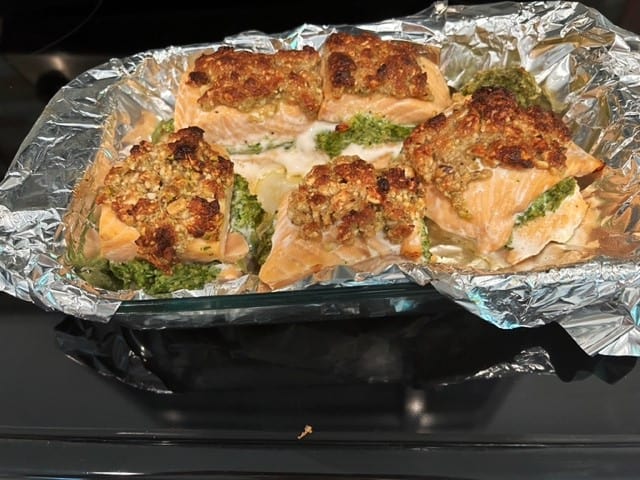
Stuffed Salmon Fillets, Israeli-Style (Vegetarian, Pareve)
Serves 6
Cook’s Tips:
*Filling and topping may be prepared ahead and refrigerated.
*Substitute any nuts for pistachios.
Ingredients:
6 salmon fillets, 5-6 ounces each
Filling:
2 green onions, sliced
1½ cups parsley with stems, packed
1 teaspoon bottled chopped garlic
3 tablespoons olive oil
2 tablespoons fresh lemon juice
1 teaspoon freshly ground pepper
¾ teaspoons salt
1 cup nuts such as cashews
Topping:
2 tablespoons tahini
2 teaspoons mustard
1 tablespoon olive oil
1 tablespoon honey
¾ cup pistachios
½ teaspoon each salt and pepper
Directions:
Rinse salmon in cold water and pat dry. Set aside.
Prepare filling: Place all filling ingredients in a food processor. Process finely. Set aside.
To prepare Topping: Place all ingredients in a food processor, and process to a coarse consistency. Set aside.
To Assemble: Preheat oven to 415 degrees. Spray a 9×13-inch baking dish with nonstick baking spray. Place 3 salmon fillets in the dish, 1 inch apart. Press about ⅓ cup filling over each spreading to the edges.
Top with remaining fillets. Spread about ¼ cup topping over each and press lightly.
Bake in preheated oven for 25 to 30 minutes. Flakes should be opaque when separated with a knife. If browning too quickly, cover loosely with aluminum foil.
Cool 10 minutes before cutting each fillet in half. May be served at room temperature.
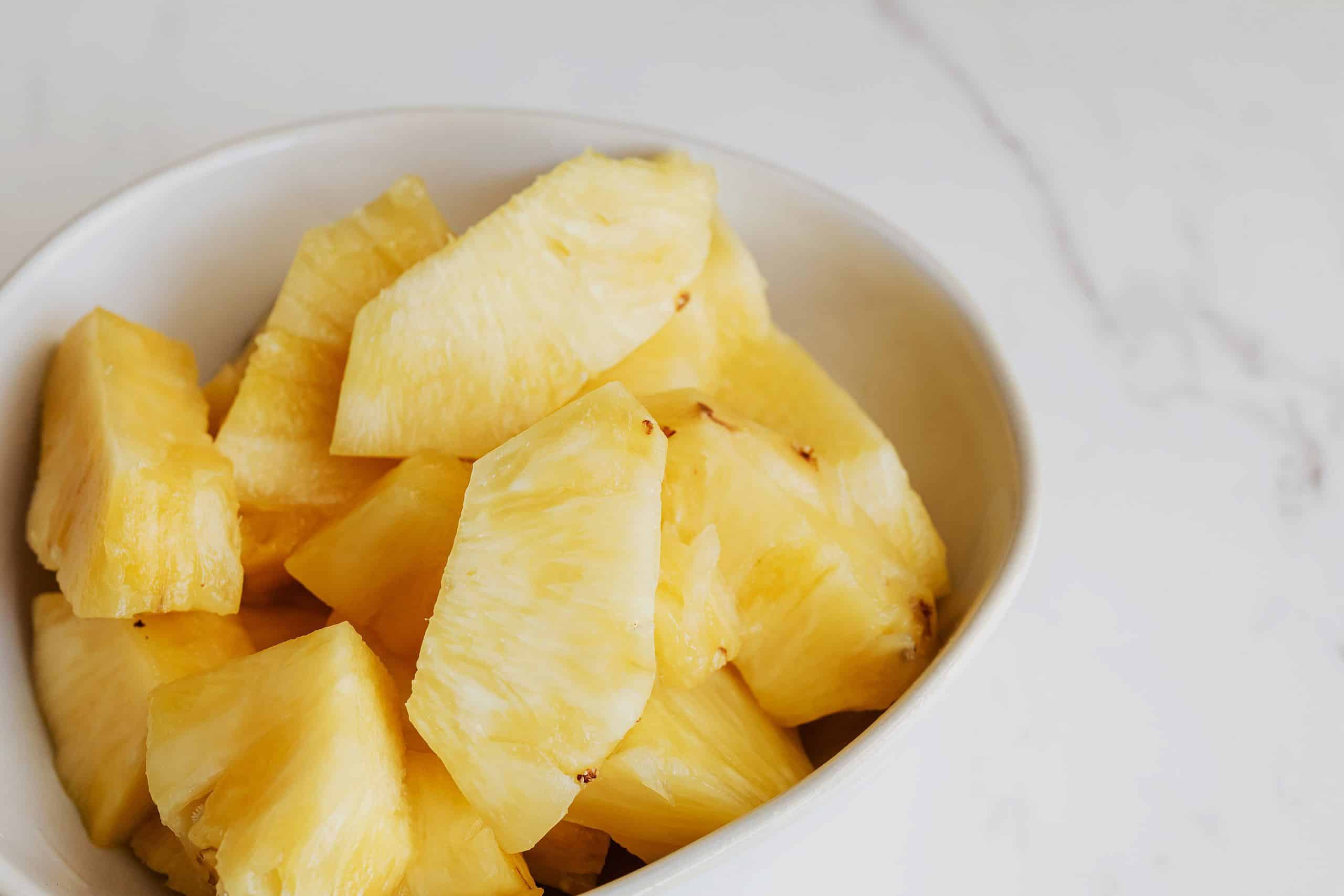
Clove-Scented Pineapple(Vegetarian, Dairy)
Serves 6
Cook’s Tips:
*Use canned pineapple instead of fresh. Pat dry first.
*For pareve, substitute margarine for butter.
*Can swap maple syrup instead of honey.
*Make a parfait. Layer in glasses with vanilla ice-cream or nondairy frozen yogurt.
Ingredients:
3 cups pineapple chunks
1 tablespoon butter or margarine
2 tablespoons honey or maple syrup
4-6 whole cloves
Directions:
Pat pineapple chunks with paper towels to dry.
Heat the butter and honey over medium-high heat. Add the pineapple and stir to coat with honey mixture. Increase heat to high.
With a spatula, turn pineapple chunks as they brown, 1 to 2 minutes.
Insert cloves into the pineapple. Transfer to a serving dish.
Serve warm or at room temperature.

Halvah-Stuffed Dates (Dairy)
Makes 10-12
Cook’s Tips:
*Medjool dates are large, sweet and soft, originally grown in Morocco and now grown in Israel, the United States and the Middle East.
*Halvah is a sesame-seed confection.
*For pareve, substitute orange juice for yogurt.
Ingredients:
3 tablespoons halvah, crumbled finely
1 teaspoon plain yogurt
pinch nutmeg
1 package (8 ounces) pitted Medjool dates
6-8 pistachios, finely chopped (optional)
Directions:
In a cup, mix the halvah, yogurt and nutmeg. The mixture should be stiff.
Open the dates to flatten them as much as possible. Spoon 1 teaspoon of the halvah mixture into each. Press to partially close.
Sprinkle with pistachios (optional).
Serve at room temperature or chilled.
Ethel G. Hofman is a widely syndicated American Jewish food and travel columnist, author and culinary consultant.







